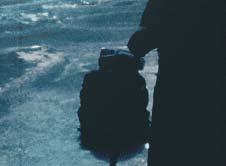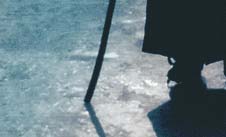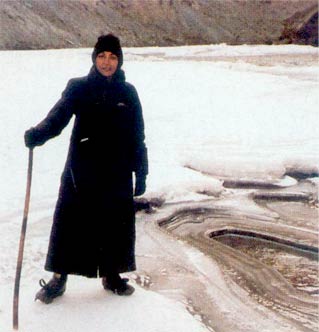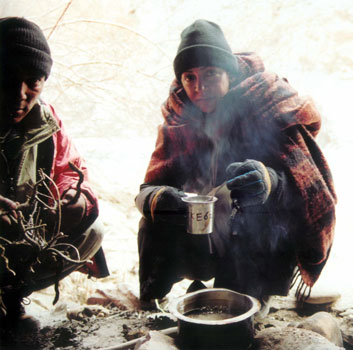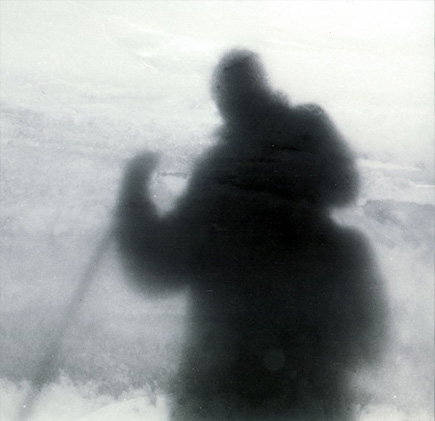
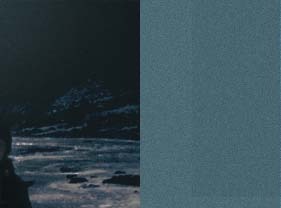
The Tchadar Expedition, Zanskar valley of Ladakh JAN 9 - 20, 2004 |
|
THE FROZEN RIVER TREK I have been wanting to do this trek since the last two years. But something or the other kept coming up each time. This year I had planned it for months in advance and was determined to not let myself down. My friend Milan, a photographer in Delhi, who had done the trek earlier with a group of foreigners, gave me a few good tips. My camera had broken down at the last minute, and I had to borrow a camera from another friend before taking off. I landed in Leh on the 9th Jan. I checked into a guest house just outside of town near the Shanti Stupa. It was freezing cold. For the first 4-5 days I just walked around with my camera, getting acclimatized. I wanted to do this trek alone. Though it may sound unusual but that’s the way I had planned it. I did try to tie up with some group or the other, but when nothing worked, I was quite relieved. I wanted the river all to myself. Tsering, my hotel owner organised two reliable porters to go along with me. They were locals from Zanskar - Lobzan and Rigzin - who were well versed with the tricky terrain. We picked up food stuff from the local market – Maggie noodles and soup packets, Muesli, Tsampa, the staple food of the Ladakhis, dried vegetables, butter for salt tea, a bottle of kerosene, and a match box etc. The basic essentials. Tsering had one look at my fancy Club Monaco jacket and rejected it. ‘You will ruin it. It will have holes all over from sitting next to the fire.’ He told me. Later he takes me to the market and makes me buy a long coat, a down jacket for just a hundred rupees. I was thrilled. My snow boots cost another three hundred, the kind local women wear in the winter. When people heard that I am doing the Tchadar Expedition, they dissuaded me – ‘Nahin memsaab, it is very difficult, you should not go alone.’ But as I had made up my mind and had waited two years to go this, I was not going to be dissuaded. I was dying to see the Zanskar valley in the winter, to see the beauty of the river. I didn’t argue back, but quietly left. 14th morning, we drove in the local bus from Leh up to the confluence point of the rivers Indus and the Zanskar. From here we cross the bridge over the Indus and move into the Zanskar valley. Three and a half hours drive got us to a place called Chilling. Here’s where the trek begins. This is a little three-house-and-a-gompa village where the kachcha road ends. We took a little breather here – had some Thukpa, a local meal, and started our walk - over the frozen river. I had to wear crampons under my shoes. These
are little spiked metal fittings that grip the ice as you walk
and keeps you from slipping. It took me a couple of hours to
get used to walking on ice. I was slow initially, not sure what
I was stepping on to. But the wooden rod which Lobsan had pulled
out of the roof of the Chilling guest house, served as my walking
stick. I would keep tapping on the ground as I walked.
At times the river opens up, places where the ice has melted and one needs to walk up on the steep rocks to go across to the frozen part of the river again. We had to do this rock climbing several times during the trek.
The first day was a four to five hour walk. Before it got dark we had to look for a shelter. There are little caves along the riverbed – not quite caves, just little gouges in the rocks which provide shelter for the night and keep you protected from the hard wind. Once we found a night halt, we would go looking for driftwood trapped in the rocks. A bonfire would be made inside the cave and we were able to cook our nightly meal. We hadn’t carried a stove or tents. We were traveling like the locals from Zanskar. After dinner, (a local dish called ‘Thukpa’—vegetable stew) Lobsan and Rigzin would sit chatting by the fire,speaking in Ladakhi, and I would sit with my note pad making travel notes, and eventually slip into my sleeping bag right next to the fire. The night sky over the frozen river was for me an unforgettable sight. Once the embers died, all I could hear was the faint crunch of ice moving along the dark waters. It was fascinating.
I remember the first night halt. While the porters were preparing a meal, I stepped out just to get a feel of the water, the rocks, the sky. As we were camping on the riverbed we could hear the water flowing under the ice and snow. It was pitch dark, although there was a moon in the sky and the black rocks were glistening - it was very strange and unreal sight. Then I looked up at the sky and I was completely bewildered. I felt I am looking at a computer generated image of a star-studded sky. This couldn’t be real. It can only be achieved with the help of computer graphics. They were so close, just fingertips away, that I felt I could just reach out my hand and touch them. It was awesome. We were on the river for six days. Our last
day on the river was the most challenging one. It had snowed
all night and the beauty of the river was something more than
awesome. We started off early, around 5.30 in the morning. It
was dark and the stars were still out. We had been told that
there is a very dangerous patch up ahead where the river has
opened up and the rocks are too steep to climb. We were skeptical.
We had no ropes or gadgets to help us rock climb. Ek to, my
left knee, which I had injured earlier in a car accident, was
already acting up. Then the snow had covered the whole landscape
in such a way that it was impossible to see where you are putting
your foot down. The towering vertical rock face did not give
you any foothold. Lobsang climbed up in a few minutes. It was
unbelievable. There was no way I could do it. But then, we heard
sounds. A group of locals were heading down the river towards
Leh. They were carrying ropes and all of us helped each other
climb the rocks and go across to the frozen part of the river.
This little patch took us two and a half hours to traverse.
As the trek was coming to an end, I felt like turning around and start walking towards Zanskar all over again. I kept looking back at the river. This experience has opened so many areas in my head. The poet in me was completely captivated, and I want to return. Night comes with deep primal sounds a death wish?
I undertook this trek with a bad left knee,
but I’ll keep doing it till my knee gives me saath…
woh jab saath nahin dega to I will take a stick. When that doesn’t
work, then I might have to sit back and tell someone, “Better
cart me through this one!”
|
